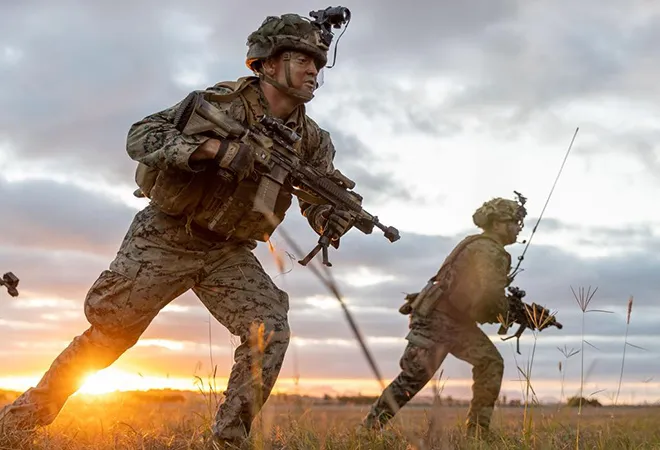
Australia’s
Defence Strategic Review 2023 (DSR2023), which was publicly released on 24 April, signals the biggest changes in Australia’s defence posture in at least 50 years. The Review, which was commissioned by the newly-elected Albanese Labour government in 2022, establishes a road map for the urgent restructuring of Australia’s basic defence strategy and capabilities to respond to a rapidly changing threat environment. The Review comments that the Australian Defence Force (ADF) as currently constituted and equipped is “not fit for purpose” and proposes fundamental changes to Australia’s defence strategy and posture. All of its recommendations have been accepted by the government.
Changes to Australia’s defence strategy and overall posture
The Review proposes the following key changes to Australia’s defence strategy and overall defence posture:
- National defence: For decades, Australian strategy has been more or less based on the ‘Defence of Australia’ by the Australian Defence Force (ADF). This will be changed to a focus on ‘National Defence’ through a whole of government/nation effort to improve all-round resilience across all domains (sea, air, land, cyber, and space).
- Strategy of denial: Australia will pursue a strategy of deterrence through denial that includes a focus on anti-access/area denial capabilities including long-range strike and undersea capabilities.
- Alliance and regional partnerships: The alliance with the United States (US) will remain central to Australia’s security and strategy and will become even more important in the coming decades. Investing in other Indo-Pacific partnerships, including with India, are also essential.
- From a Balanced Force to a Focused Force: The ADF will be transformed from a Balanced Force to a Focused Force required that the ADF had capabilities to respond to a range of threats, including low-level threats related to continental defence, regional operations, as well as global support for the US. Instead, the ADF force will, in future be framed around critical capabilities, which, in, practice will require de-prioritising capabilities deemed non-essential (e.g. armoured capabilities).,
- From a Joint Force to an Integrated Force: The ADF will move from its current configuration as a joint force (in which all forces operate under joint command but where the three services retain primary responsibilities for raising, training, and sustaining their forces) to an integrated force across all domains. This will include joint enablers such as integrated logistics and communications.
- Indigenous manufacture of long-range missiles: Australia will develop indigenous long-range missile manufacturing.
- Climate change and disaster relief: The ADF should, in future, be only the force of last resort for domestic disaster relief. The disaster relief role will be assumed by other Federal and State agencies.
- Urgency: The Review notes that Australia’s strategic posture is no longer based on a 10-year warning time as the basis for defence planning. Instead, the Review identified three periods: 2023–25 for urgent matters, the period 2026–2030, and the period 2031 and beyond.
Army to focus on littoral operations
The DSR2023 signals some of the most obvious changes for the Australian Army, which will abandon its long-held balance force structure and instead be optimised for littoral manoeuvre operations (in some ways analogous to marines). Many units will be relocated to Australia’s northern coast.
Key changes for Australia’s Army will include:
- The Australian Army will have much reduced armoured capabilities. This will involve a drastic reduction (by more than two-thirds) in spending on new tanks and infantry fighting vehicles.
- No acquisition of additional self-propelled howitzers, which are deemed to have insufficient range or lethality.
- Reallocation of spending to littoral manoeuvre capabilities, including small craft and landing craft.
- Army will acquire a new long-range land-based maritime strike role, including through HIMARS systems.
Navy as a more heavily armed force
The majority of Australia’s defence spending is already on maritime capabilities, which will only grow significantly in the future.
The Review confirms previously announced decisions to acquire a fleet of nuclear-powered (and conventionally armed) submarines from the United States and the United Kingdom at a
reported cost of up to AUD 368 billion. These will be principally based at Fremantle on Australia’s west coast, along with rotational deployments of American and British nuclear submarines. The Review recommends the establishment of another nuclear-powered submarine base on Australia’s East Coast.
The DSR2023 signals some of the most obvious changes for the Australian Army, which will abandon its long-held balance force structure and instead be optimised for littoral manoeuvre operations.
But, DSR2023 also signals potentially significant changes in the Navy’s surface fleet, including a review of Navy Surface fleet by Vice Admiral William Hilarides, USN (Ret.). There has been speculation that this will involve a reduction in the planned nine UK-designed Hunter Class frigates, which have been
criticised for being too lightly armed and building a larger number of heavily armed corvettes.
Air Force to protect and disperse assets
Australia’s Air Force will be instructed to urgently harden its network of airfields across northern Australia (including the Indian Ocean Cocos Island territory) to protect and disperse assets.
Australia will not acquire US-made B-21 bombers at this stage. However, the Review endorses a ramping up of indigenous production of attritable ‘loyal wingman’ drones that operate alongside crewed aircraft.
Australia and the Indian Ocean region
The Review confirms previous statements made in the Defence Strategic Update 2022, that Australia’s primary area of military interest is its immediate region encompassing the north-eastern Indian Ocean through maritime Southeast Asia into the Pacific, including its northern approaches. For India, this means that the ADF will remain focused on the eastern side of the Indian Ocean and will seek to avoid future commitments in the western Indian Ocean.
While the Review is principally focused on Australia’s capabilities and not regional relationships, it does specifically recommend the expansion of Australia’s Defence Cooperation Program in the Indian Ocean region. This could potentially include the expansion of Australia’s Pacific Maritime Security Program (popularly known as the Pacific Patrol Boat Program).
Conclusion
The DSR2023 represents a major turning point in Australian defence. Its call for fundamental changes to Australia’s defence strategy and posture should be a wake-up call not only for Australia but for its partners throughout the Indo-Pacific. It signals that time is not on our side.
This article was written as a part of the Australia India Institute’s Defence Program undertaken with the support from the Australian Department of Defence. All views expressed in this article are those of the author only.
David Brewster leads the Australia India Institute’s Defence Program and is also a Senior Research Fellow at the National Security College, ANU.
Samuel Bashfield is defence researcher on the Australia India Institute’s Defence Program, Australia
The views expressed above belong to the author(s). ORF research and analyses now available on Telegram! Click here to access our curated content — blogs, longforms and interviews.



 Australia’s
Australia’s  PREV
PREV



